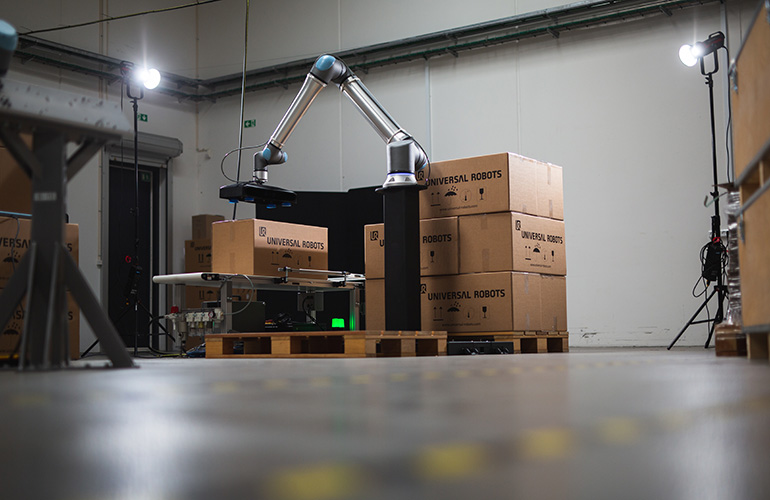Teradyne’s robotics group makes $89M in Q3

Universal Robots, part of Teradyne’s industrial automation group, recently released its UR20 cobot. | Source: Universal Robots
Teradyne saw a small backslide in revenue in its industrial automation group, a 2% decrease, in Q3 of 2022 compared to the same time period last year. The group brought in $89 million in revenue for Q3 2022.
The industrial automation group’s revenue is a decline from Q2 of this year when it brought in $101 million in revenue. The group consists of Energid, Mobile Industrial Robots (MiR), which just merged with AutoGuide Mobile Robots, and Universal Robots (UR). Energid’s revenue is included with UR’s.
During Q3, UR brought in $73 million, and MiR brought in $16 million. UR sales decreased 5% during the quarter, while MiR sales rose 17% from the same quarter last year. Both companies saw a decrease in sales from last quarter when UR brought in $83 million and MiR brought in $17 million.
For the first 9 months of 2022, 41% of Teradyne’s industrial automation sales were to Europe, 29% to the U.S. and 11% to China and the remainder to the rest of the world.
Greg Smith, named president of Teradyne on July 1, 2022, attributed the slower-than-expected growth to two factors.
“First, slowing industrial activity, especially in Europe, where PMI has dropped below 50 in July and has remained in that contraction zone since. Europe is our largest end market for automation, and this is a 10-point headwind to growth,” Smith said during the company’s Q3 earnings call. “Second, labor scarcity continues in our distribution channel, which we expect to reduce growth by about five points.”
Despite slow growth, Teradyne is optimistic about UR’s future. The company has seen higher demand than expected for its higher payload UR20 cobot released earlier this year. Teradyne expects the UR20 to start shipping in 2023 when it will start contributing to financial results.
UR has also seen a lot of growth in welding. Its welding channel grew over 80% in the first nine months of 2022 compared to the same time last year, and it expects to ship over 1,200 robots in that vertical.
Inside the AutoGuide/MiR merger
Teradyne combined MiR and AutoGuide Mobile Robots at the end of Q3, with the integrated company officially being called Mobile Industrial Robots. The company’s headquarters will be in Odense, Denmark, where MiR has been based since 2013 when it was founded.
Prior to the merger, MiR offered a range of AMRs capable of carrying payloads and pallets up to 3,000 lb. (1350 kg). By combining with AutoGuide, the portfolio will expand to include high-payload AMR tuggers and forklifts that will operate on the MiRFleet software.
Smith said Teradyne decided about a year ago that the best way to differentiate its AMR business was to provide a broad product line under a single software control.
“We heard over and over again from big customers that they were struggling to implement complex workflows because complex workflows generally need AMRs to interact with each other,” Smith said. “The dominant way people were talking about that happening was through fleet management. That was putting those customers into an uncomfortable position where they didn’t know who to go to when things from multiple vendors didn’t work right. ”
Smith said Teradyne wants to take responsibility for the performance of the hardware and software and turn to partners to ensure a positive customer experience.
“If you look at any AMRs, whether they’re ours or someone else’s, customers can take up to two years to go from an initial pilot to a volume deployment. That’s because they have to work out their processes and adapt to the technology,” he said. “In some cases, like automakers, they have to invent new jobs. They don’t have people who know how to maintain AMRs, so they have to figure out how to fit that into their union regulations. That’s a complex issue to work through. We believe the ultimate destination for AMRs has incredible potential, but we need to simplify the process. And simplifying that process for us meant putting all of our AMRs under one software control and engaging with customers as one organization.
Smith said the bulk of the of work went into reworking the sensor suite of the AutoGuide robots to optimize their performance with MiR’s software and to enhance the MiR software to handle the higher speeds of the heavy payload vehicles from AutoGuide.
“The basic chassis stays the same, but because of the higher top speeds, we need to look much further ahead of the vehicle to react to obstacles and do the right thing. We had to modify the sensor suite of the AutoGuide robots and enhance the MIR software so it could handle the specific requirements of the heavy payload space. And that’s faster speed and more control of the path the AMRs take.”
The post Teradyne’s robotics group makes $89M in Q3 appeared first on The Robot Report.
from The Robot Report - Robotics News, Analysis & Research https://ift.tt/BSwcjhZ
via artificialconference

Comments
Post a Comment